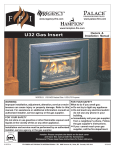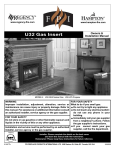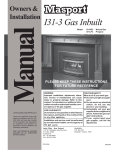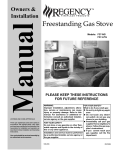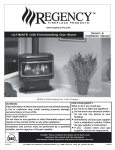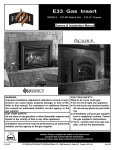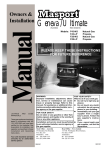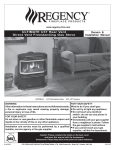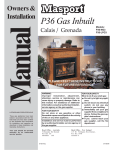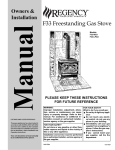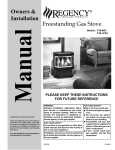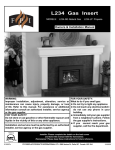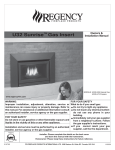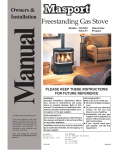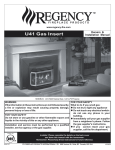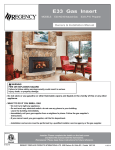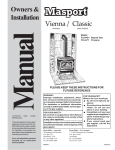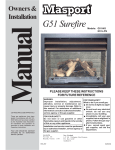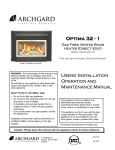Download Hampton Direct U32-LP2 User's Manual
Transcript
www.hampton-fire.com www.regency-fire.com U32 Gas Insert Owners & Installation Manual MODELS: U32-NG2 Natural Gas U32-LP2 Propane WARNING: FOR YOUR SAFETY Improper installation, adjustment, alteration, service or main- What to do if you smell gas: tenance can cause injury or property damage. Refer to this Do not try to light any appliance manual. For assistance or additional information consult an Do not touch any electrical switch: authorized installer, service agency or the gas supplier. do not use any phone in your building. FOR YOUR SAFETY Immediately call your gas supplier Do not store or use gasoline or other flammable vapours and from a neighbour's phone. Follow liquids in the vicinity of this or any other appliance. the gas supplier's instructions. If you cannot reach your gas Installation and service must be performed by an authorized supplier, call the fire department. installer, service agency or the gas supplier. Tested by: Installer: Please complete the details on the back cover and leave this manual with the homeowner. Homeowner: Please keep these instructions for future reference. 918-011a FPI FIREPLACE PRODUCTS INTERNATIONAL LTD. 6988 Venture St., Delta, BC Canada, V4G 1H4 10/08/03 FPI GAS INSERT TO THE NEW OWNER Congratulations! You are the owner of a state-of-the-art Gas Insert by FPI. The FPI Gas Insert Series of hand crafted appliances has been designed to provide you with all the warmth and charm of a fireplace, at the flick of a switch. The models U32-NG2 and U32-LP2 of this series have been approved by Warnock Hersey for both safety and efficiency. As it also bears our own mark, it promises to provide you with economy, comfort and security for many trouble free years to follow. Please take a moment now to acquaint yourself with these instructions and the many features of your FPI Fireplace. Note: Oversize faceplate is 44" x 28" INFORMATION FOR MOBILE/MANUFACTURED HOMES AFTER FIRST SALE This FPI product has been tested and listed by Warnock Hersey as a Direct Vent Wall Furnace to the following standards: CAN/ CGA-2.17-M91, and ANSI Z21.88-1998/CSA 2.33-M98. This Direct Vent System Appliance must be installed in accordance with the manufacturer's installation instructions and the Manufactured Home Construction and Safety Standard, Title 24 CFR, Part 3280, or the current Standard of Fire Safety Criteria for Manufactured Home Installations, Sites, and Communities ANSI/NFPA 501A, and with CAN/CSA Z240-MH Mobile Home Standard in Canada. See page 6 for additional requirements. This appliance installation must comply with the manufacturer's installation instructions and local codes, if any. In the absence of local codes follow the current National Fuel Gas Code, ANSI Z223.1 and the current National Electrical Code ANSI/NFPA 70 in the U.S.A., and the current CAN/CGA B149 Gas Installation Code and the current Canadian Electrical Code CSA C22.1 in Canada. This FPI Mobile/Manufactured Home Listed appliance comes factory equipped with a means to secure the unit. This FPI Mobile/Manufactured Home listed appliance comes equipped with a dedicated #8 ground lug to which an 18 gauge copper wire from the steel chassis ground must be attached. 2 U32-2 FPI Direct Vent Gas Insert TABLE OF CONTENTS FPI GAS INSERT Unit Dimensions ................................................................... 2 Operating Instructions Safety Label ......................................................................... 4 Operating Instructions ......................................................... 17 Lighting Procedure .............................................................. 17 Shutdown Procedure ........................................................... 17 First Fire ....................................................................... 17 Automatic Convection Fan Operation ................................. 17 Normal Operating Sounds of Gas Appliances ................... 17 Copy of Lighting Instruction Plate ....................................... 18 Installation For Your Safety ...................................................................... 5 Specifications ........................................................................ 5 Gas Pressure Testing ........................................................... 5 Installation into a Solid Fuel Burning Fireplace or Factory Built Fireplace .................................................... 5 General Safety Information .................................................... 5 Installation Checklist ............................................................. 5 Manufactured Mobile Home Additional Requirements ........ 6 Materials Required ................................................................ 6 Minimum Fireplace Clearances ........................................... 6 Clearances to Combustibles ................................................ 6 Gas Connection .................................................................... 7 Venting ......................................................................... 7 - Flue Liner Installation .................................................. 7 Gas Pressure Test ................................................................ 8 Gas Insert Aeration System .................................................. 8 Optional Brick Panel .............................................................. 8 Log Installation ...................................................................... 9 Faceplate & Trim ................................................................. 10 Standard Flush Door ........................................................... 11 Optional Flush Trim ............................................................. 11 Optional Door Fire Screen .................................................. 11 Flush Louvers ...................................................................... 11 Optional Bay Door ............................................................... 12 Optional Bay Trim ................................................................ 12 Bay Louvers ....................................................................... 12 Hampton Cast Faceplate Installation ................................. 13 Hampton Cast Faceplate Grill ............................................ 14 Optional Wall Thermostat ................................................... 15 Optional Remote Control .................................................... 15 Final Check ....................................................................... 15 Wiring Diagram ................................................................... 16 U32-2 FPI Direct Vent Gas Insert Maintenance Maintenance ....................................................................... 18 General Vent Maintenance .................................................. 19 Log Replacement ................................................................ 19 Glass Gasket ....................................................................... 19 Gold Plated Trim ................................................................. 19 Door Glass ....................................................................... 19 - Flush Glass Replacement ......................................... 19 - Bay Glass Removal ................................................... 19 Fan Maintenance ................................................................. 20 Valve Removal & Replacement .......................................... 21 Parts List ....................................................................... 22 Warranty Warranty ....................................................................... 27 3 SAFETY LABEL This is a copy of the labels that accompany each U32-2 Gas Insert. We have printed a copy of the contents here for your review. The safety label is located on a plate inside the base of the unit visible when the bottom louver is opened. NOTE: FPI units are constantly being improved. Check the label on the unit and if there is a difference, the label on the unit is the correct one. For the State of Massachusetts, installation and repair must be done by a plumber or gasfitter licensed in the Commonwealth of Massachusetts. For the State of Massachusetts, flexible connectors shall not exceed 36 inches in length. For the State of Massachusetts, the appliances individual manual shut-off must be a t-handle type valve. 4 U32-2 FPI Direct Vent Gas Insert INSTALLATION IMPORTANT: SAVE THESE INSTRUCTIONS The FPI Gas Insert must be installed in accordance with these instructions. Carefully read all the instructions in this manual first. Consult the building authority having jurisdiction to determine the need for a permit prior to starting the installation. NOTE: Failure to follow the instructions could cause a malfunction of the heater which could result in death, serious bodily injury, and/or property damage. Failure to follow these instructions may also void your fire insurance and/or warranty. FOR YOUR SAFETY This appliance requires air for proper combustion. Always provide adequate combustion and ventilation air. Follow instructions and information in CAN/CGA B149 (in Canada) or the National Fuel Gas Code ANSI Z223.1 (in the USA), regarding requirements for combustion and ventilation air. SPECIFICATIONS At pressures over 1/2 psig, the pipe to the unit must be disconnected. Gas Input Capacity: Natural Gas 30,000 Propane 30,000 Min. Input Natural Gas Propane 15,300 15,000 Btu/h Btu/h Btu/h Btu/h Fuels: Approved for use with both natural gas, and propane. Approved as is for use at 0' to 4,500' (0-1370m). Electrical: 120V A.C. system. Circulation Fan: Variable speed, 110 CFM. Log Set: Ceramic fibre, 7 per set. Vent System: 3" co-linear aluminum flex. The efficiency rating of the appliance is a product thermal efficiency rating determined under continuous operating conditions and was determined independent of any installed system. U32-2 FPI Direct Vent Gas Insert GAS PRESSURE TESTING The appliance must be isolated from the gas supply piping system by closing its individual manual shut off valve during any pressure testing of the gas supply piping system at test pressures equal to or less than 1/2 psig. (3.45 kPa). INSTALLATION INTO A SOLID FUEL BURNING FIREPLACE OR FACTORY BUILT FIREPLACE The U32-2 Gas Inserts have been tested and approved to be vented into any masonry fireplace or approved solid fuel burning factory built fireplace that will allow the insert to physically fit into the firebox. Refer to page 6 for minimum fireplace clearances. If the factory built fireplace* height is too low for your Insert, you may remove the smoke baffle plate, damper, refractory (firebricks), glass doors, screen rails, screen mesh and log grates from the factory built fireplace as long as these items are saved and are reinstalled in the event that the Insert is removed. Smoke shelves, shields and baffles may be removed if attached by mechanical fasteners. If any part is removed it must not weaken the structural integrity of the factory built fireplace. NOTE: Any alterations made to the listed solid fuel burning factory built fireplace may void the listing of the fireplace. *Check with your local inspector before commencing with this installation. BEFORE YOU START Safe installation and operation of this appliance requires common sense, however, we are required by the Canadian Safety Standards and ANSI Standards to make you aware of the following: General Safety Information 1) The appliance installation must conform with local codes or in the absence of local codes, with CAN/CGA B149 (in Canada) or the National Fuel Gas Code ANSI Z223.1 in the U.S.A. This appliance should be installed by a qualified gas fitter technician only. 2) Installation and repair should be done by a qualified service person. 3) The appliance should be inspected before use and at least annually by a professional service person. More frequent cleaning may be required due to excessive lint from carpeting, bedding material, animal hair, etc. It is imperative that control compartments, burners and circulating air passageways of the appliance be kept clean. 4) See general construction and assembly instructions. This appliance may only be installed in a vented, noncombustible fireplace. 5) This appliance is Listed for bedroom installations when used with a Listed Millivolt Thermostat. Some areas may have further requirements, check local codes before installation. 6) Always connect this insert to a vent system venting to the outside of the building envelope. Never vent to another room or inside a building. Make sure that the vent is properly sized and is of adequate height to provide the proper draft. 7) Inspect the venting system annually for blockage and any signs of deterioration. 8) Any glass removed for servicing must be replaced prior to operating the appliance. 9) To prevent injury, do not allow anyone who is unfamiliar with the operation to use the fireplace. 10) Due to high temperatures, the appliance should be located out of high traffic areas and away from furniture and draperies. Children and adults should be alerted to the hazards of high surface temperatures, especially the fireplace glass and gold trims, and should stay away to avoid burns or clothing ignition. Young children should be carefully supervised when they are in the same room as the appliance. Clothing or other flammable material should not be placed on or near the appliance. Emissions from burning wood or gas could contain chemicals known to the State of California to cause cancer, birth defects or other reproductive harm. INSTALLATION CHECKLIST Before installing vent system ensure that the damper plate is open and secure to prevent the damper plate from falling down and crushing the liner. The FPI Gas Insert is installed as listed below. 5 INSTALLATION 1) Check all clearances to combustibles, page 6. 2) Make the gas connection. See page 7. 3) Install the 3" flue liner to the sliding connector plate. See page 7. 4) Slide the unit half way into the fireplace. 5) Pull the vent connector plate through the tapered brackets and fasten to the front plate. See page 7. MATERIALS REQUIRED No electrical power supply is required for the gas control to operate. A 120 Volt AC power cord is hooked up to the fan. Plug the 3 wire cord into a suitable receptacle. Do not cut the ground terminal off under any circumstances. When connected with 120 volts, the appliance must be electrically grounded in accordance with local codes, current version of CSA C22.1 (in Canada) or in the absence of local codes, with the National Electrical Code ANSI/NFPA 70-1987. 6) Slide the unit fully into the fireplace. 7) Test gas pressure, page 8. Check aeration system, page 8. 8) Install the optional brick panels. See page 8. 9) Install the log set. See page 9. 10) Assemble and install the faceplate and trim. See page 10. 11) Install the glass front (flush or bay). See pages 10 and 11. NOTE: This unit is equipped with a heat sensor thermodisc which will prevent the blower from operating until the unit reaches the correct temperature. MINIMUM FIREPLACE DIMENSIONS CLEARANCES TO COMBUSTIBLES Minimum Clearances to Combustibles From Unit A 10" / 255 mm B 47.5" / 1205 mm C see Dia. 2 & 3 Sides Ceiling Mantel From Standard Surround (26" x 40") Sides D 4" / 100 mm Ceiling E 41.5" / 1055 mm Mantel see Dia. 2 & 3 Max. Mantle Depth G H I J 12" / 305 mm (see Dia. 2) 0" / 0 mm 16" / 405 mm 40" / 1015 mm Min. Alcove Width K Max. Alcove Depth L 48" / 1220 mm 36" / 915 mm Hearth Height Hearth Depth Hearth Width The minimum fireplace clearances & dimensions for the FPI gas insert are shown in the following diagrams: 12) Install optional glass trim, or door fire screens. See pages 11 and 12. 13) Install both louvers (flush or bay). See pages 11 and 12. 14) Install optional remote control or wall thermostat, pages 15. 15) Final check: Before leaving this unit with the customer, the installer must ensure that the appliance is firing correctly. This includes: a) Clocking the appliance to ensure the correct firing rate. Diagram 1 b) Adjusting the primary air, if required, to ensure that the flame does not carbon. See page 8. Combustible Mantel Clearances with Bay & Flush Louvers in Masonry and Factory Built Fireplace Installation c) Ensuring that the appliance is venting correctly. MANUFACTURED MOBILE HOME ADDITIONAL REQUIREMENTS 1) Ensure that structural members are not cut or weakened during installation. 2) Ensure proper grounding using the #8 ground lug provided. 3) Appliance must be anchored to the floor with the supplied anchoring methods. *Note: If you are installing the Molded Faceplate, the minimum fireplace dimensions are as follows: Width (at front): 29" (737mm) Depth: 15" (381mm) Diagram 2 6 U32-2 FPI Direct Vent Gas Insert INSTALLATION pass through the chimney above the appliance. Move the appliance into the exact location where it is to be installed. Ensure that the Insert is level. mend using the Simpson Dura-Vent System (923GK adapter and 991 high-wind cap). The Air Intake pipe must be attached to the inlet air collar of the termination cap. VENTING THE APPLIANCE MUST NOT BE CONNECTED TO A CHIMNEY FLUE SERVING A SEPARATE SOLID FUEL BURNING APPLIANCE. This appliance is designed to be attached to two 3" (76mm) co-linear aluminium flex running the full length of the chimney. The flue length must be a minimum length of 8 ' (2.44m) and a maximum of 35' (10.7m). See chart below for minimum distances from roof. Periodically check that the vent is unrestricted. Diagram 3 Note: A noncombustible mantel may be installed at a lower height if the framing is made of metal studs covered with a noncombustible board. GAS CONNECTION Masonry chimneys may take various contours which the flexible liner will accommodate. However, keep the flexible liner as straight as possible, avoid unnecessary bending. FLUE LINER INSTALLATION 1) Cut the flex liner as required. 2) Mark the end of one liner to indicate Inlet. The Air Intake pipe must be attached to the inlet air collar of the termination cap. 3) Connect the other end of the above liner to the inlet side of the termination adaptor, seal connection with high temperature silicone. Secure with gear clamp. Part # 948-305 946-529 4) Connect the 2nd liner to the exhaust side of the adaptor, seal connection with high temperature silicone. Secure with gear clamp. Description 3" Flex - 35 ft. Co-linear DV Vertical Termination Cap GAS CONNECTION WARNING: Only persons licensed to work with gas piping may make the necessary gas connections to this appliance. 1) If the appliance is to be installed into an existing chimney system, thoroughly clean the masonry or factory built fireplace. 2) The appliance is provided with an opening on the left hand side of the control compartment. A 3/8" NPT gas supply pipe must be brought near this inlet hole. 3) Locate the center point where the vent will 5) Install flashing. 6) Insert both liners into chimney, passing through the damper opening. Alternate Approved Caps 980 Vertical Termination Cap 991** High Wind Cap 923GK** 3" Co-linear Adaptor with flashing *Recommended for installations up to and including 25 ft. (7.6m) in length/height. ** For installations in excess of 25 ft. (7.6m) or in areas of consistently high winds, we recomU32-2 FPI Direct Vent Gas Insert 7) Install termination cap. 8) Connect the marked end of the liner to the inlet collar of the vent connector plate marked with an "I", seal connection with high temperature silicone. Secure with gear clamp. 7 INSTALLATION 2) Loosen the "IN" and/or "OUT" pressure tap(s), turning counterclockwise with a 1/ 8" wide flat screwdriver. 3) Attach manometer to "IN" and/or "OUT" pressure tap(s) using a 5/16" ID hose. 4) Light the pilot and turn the valve to "ON" position. 5) The pressure check should be carried out with the unit burning and the setting should be within the limits specified on the safety label. 9) Connect the 2nd liner to the exhaust collar marked with an "E", seal connection with high temperature silicone. Secure with gear clamp. 1) Unwrap the brick pattern panels from the protective wrapping. 2) Remove the glass front if it is already installed, see page 11. 3) Put the rear brick panel flat against the back of the unit. 6) When finished reading manometer, turn off the gas valve, disconnect the hose and tighten the screw (clockwise) with a 1/8" flat screwdriver. Note: Screw should be snug, but do not over tighten. GAS INSERT AERATION SYSTEM The air shutter can be adjusted by moving the adjusting wire up or down. The wire is accessed through the bottom louver opening. Open the air shutter for a blue flame or close for a yellower flame. The burner aeration is factory set but may need adjusting due to either the local gas supply or altitude. NOTE: 1) Final gas connection should be made after unit is in place to avoid damage to line when pushing the unit into position. OPTIONAL BRICK PANEL 4) Before installing the side brick panels, loosen the screws for the brick tabs enough so that you can slide the brick tabs on to the screws easily but that the tabs are secure. For the location of the side brick tab screws see diagram 1. Minimum Air Shutter Opening: 3/16" Natural Gas 1/4" Propane 2) Mill-pac may be used instead of high temperature silicone and screws may be used instead of gear clamps at connections of liner to inlet and vent collars. GAS PIPE PRESSURE TESTING Diagram 1 The appliance must be isolated from the gas supply piping system by closing its individual manual shut-off valve during any pressure testing of the gas supply piping system at test pressures equal to or less than 1/2 psig. (3.45 kPa). Disconnect piping from valve at pressures over 1/2 psig. The manifold pressure is controlled by a regulator built into the gas control, and should be checked at the pressure test point. Note: To properly check gas pressure, both inlet and manifold pressures should be checked using the valve pressure ports on the valve. 1) Make sure the valve is in the "OFF" position. Aeration Adjustment Wire PULL= Open PUSH = Close 5) Remove the brick tabs and slide the side brick panels into position. See diagram 1. Install the brick tabs. See diagram 2. CAUTION: Carbon will be produced if air shutter is closed too much. Note: any damage due to carboning resulting from improperly setting the aeration controls is NOT covered under warranty. Note: Aeration Adjustment should only be performed by an authorized FPI Installer at the time of installation or service. Diagram 2 8 U32-2 FPI Direct Vent Gas Insert INSTALLATION LOG SET INSTALLATION 3) Place Rear Log A)02-43 on the two pins on the rear log support. Read the instructions below carefully and refer to the diagrams. If logs are broken do not use the unit until they are replaced. Broken logs can interfere with the pilot operation. 6) Place the Left Top Log D)02-46 on the pin on Log C)02-56 and on top of the cutout on Log A)02-43. A)02-43 D)02-46 A)02-43 The gas log kit contains the following: C)02-56 a) b) c) d) e) f) g) h) i) j) 02-43 02-45 02-56 02-46 02-47 02-48 02-44 Rear Log Front Right Log Middle Left Log Left Top Log Center Log Middle Right Log Front Left Log Embers Rockwool Vermiculite 902-227 902-229 902-230 902-231 902-232 902-226 902-228 902-154 902-153 902-179/21 Pins on Rear Log Support Pin 4) Place Front Right Log B)02-45 on the two pins as shown. Note: Install Optional Brick Panels prior to installing logs. Cutout 7) Place the notch in Center Log E)02-47 over Log B)02-45 and across the cutout on Log A)02-43. E)02-47 B)02-45 A)02-43 B)02-45 5) Place the Middle Left Log C)02-56 on the two pins as shown. The "02" refer numbers (i.e. 02-43) are molded into the rear of each log. Notch Cutout C)02-56 Logs D)02-46 and E)02-47 in position. 1) Carefully remove the logs from the box and unwrap them. The logs are fragile, handle with care - do not force into position. 8) Position notch in Front Right Log F)02-48 on Log E)02-47 and push the bottom right edge against the bracket on the burner tray and the front edge of the rear burner. 2) Sprinkle the vermiculite around the firebox base. Take some of the embers (approx. 1/3 of the bag) and sprinkle over the vermiculite. F)02-48 E)0 2-4 7 Logs A)02-43, C)02-56, and B)02-45 in position B)02-45 Notch Vermiculite and embers. Bracket Vermiculite and Vermiculite and embers. embers. U32-2 FPI Direct Vent Gas Insert 9 INSTALLATION B)02-45 A)02-43 F)02-48 FACEPLATE & TRIM INSTALLATION 1) Lay the faceplate panels flat, face down on something soft so they don't scratch. Side View Front edge of rear burner Bracket The bottom right edge of Log F)02-48 must sit snugly against the bracket and the front edge of the rear burner. 2) Take the top faceplate and align the holes in it with the holes in the side panels. Using the screws provided, attach from the top of the panel (the holes in the top panel are slightly larger than the holes in the side panel to facilitate easier installation). Diagram 1. Rear View: Trim Assembly Diagram 2 9) Place Front Left Log G)02-44 onto the 2 front pins as shown. 5) Connect the fan switch wires by taking the black and red wires with the male ends (in the grey harness) and connect them with the wire connectors from the fan speed control. G)02-44 6) Connect the ON/OFF switch wires by taking the black and red wires with the female ends and connect them to the ON/OFF switch. 7) Tuck the wires into the faceplate to keep them away from the insert using the clip provided. Attach the clip to the rear of the faceplate to ensure that the wires do not touch the side of the unit. Diagram 3. 10) Place the embers and Rockwool on the exposed front burner tray. Rear View: Faceplate Assembly Diagram 1 11) Test fire to ensure proper light off (make sure flame flows smoothly from one end of burner to the other. If there is any flame hesitation, check that area for any blockage of the burner port. 12) Install flush glass and optional bay glass as per instructions in this manual. 46 C)02-56 E)02-4 D) 02 2-4 A)02-43 8 7 F)0 B)02-45 Hint: Don't tighten the screws down completely at this point, continue on with steps 3 and 4 and do a trial fit to the unit. Make any necessary adjustments and when it fits properly then tighten down the screws. Hearth Trim Option: Hearth Trim is an option that can be used to finish off the installation when the bottom of the fireplace is higher than the hearth or to raise the fireplace. Attach the Hearth Trim to the bottom of the faceplate side panels with the screws provided. See Diagram 1. 8) The power cord should be run behind the faceplate panel. 3) Using the connectors provided, join the left side trim (with the ON/OFF switch) to the top trim. Diagram 2. Connect the right side trim to the top trim. 9) Attach the brass trim to the faceplate by drilling a 1/8" hole through into the faceplate using the hole in the trim as a guide. Fasten the trim to the faceplate panels using the plated screws. Diagram 4. 4) Place the trim on the assembled faceplate panels, aligning the wire connections from the switches with the notch on the left side panel. 10) Attach the faceplate panels to the insert body using the 4 remaining black screws. Diagram 5. G)02-44 10 Diagram 3 U32-2 FPI Direct Vent Gas Insert INSTALLATION OPTIONAL DOUBLE DOOR FIRE SCREEN 1) Pull out the top louver. Diagram 2 Use the hook to pull the spring out until you can put the hook into the slot on the bottom door bracket. Repeat for 2nd spring. See diagram 3. Diagram 4 Diagram 3 To remove the flush door, reverse the above steps. 2) Center the screen door and hook over the flush door. 3) Open the screen door(s) and secure the screen door to the flush door front with 2 clips on the bottom left and right side. NOTE: The chain must rest on TOP of the gas inlet pipe never under it. Diagram 5 11) Push the Regency logo plate into the two holes in the bottom left corner of the faceplate. STANDARD FLUSH DOOR The standard flush door comes with a black frame. To install the frame, simply hook the top door flange onto the top of the unit and swing the door towards the unit, diagram 1. Be careful that the glass gasket does not roll up; there must be a gap between the gasket and the door lip to ensure that the door sits securely on the unit. Diagram 2. Clip locations OPTIONAL FLUSH TRIM Attach 2 round magnets to the back of the top trim piece and the other 2 to the bottom trim piece, then attach trim to the top and bottom of Flush door. Clip installed on right side. FLUSH LOUVERS 1) The top louver is held in place by friction fit, if the louver needs to be adjusted; bend the bracket out as shown in the diagram. Diagram 1a Note: Top and bottom louvers are different. Diagram 1b U32-2 FPI Direct Vent Gas Insert 2) The bottom louver has a hinge that is attached (2 screws per hinge) to the lip on bottom of the unit. 11 INSTALLATION OPTIONAL BAY DOOR The Bay louvers MUST be used with the Bay glass option. The optional Bay door is an overlay on the flush front. The standard flush door and glass must remain on the unit. Hook the top of the bay door over the flush door flange and swing the bottom against the bottom flange of the flush door. Press down on the Bay Bottom bracket and push in until it clips behind the bottom of the flush front. Removing Bay Door To remove only the Bay Door - use a screwdriver to unclip the Bay Bottom bracket from the flush door and then swing up and unhook from the top flush door flange. To remove the Bay Door & the Flush Front together, pull the hook from the slot in the bottom door bracket under the unit (see Standard Flush Door instructions above). Then pull the Bay Door and Flush door out and lift off of the flange at the top of the unit. BAY LOUVERS 1) Install top louver by sliding the two bracket clips into the brackets located on top of the bay door. See below. The fitted louver leaves a small gap between faceplate bottom and louver top. Note: If any maintenance etc. must be done in the firebox, first remove the Bay louvers and door. OPTIONAL BAY TRIM Attach 4 supplied magnets each to the back of the top and bottom trim pieces, and attach trim to the top and bottom of Bay door. Slide the valve extension knobs onto the valve knobs. Match each extension knob with the corresponding valve knob. Extension knobs are for Bay Front installations only. Robert Shaw Extension knobs for Bay Front only. 12 2) Install bottom louver by sliding the two bracket clips into the brackets located underneath the bay door. Secure with 1 screw into each Bottom Louver Mounting Bracket as per diagram below. Use the bottom hole in the bracket. 3) Slide the Robert Shaw valve extension knobs onto the valve knobs. Match the correct ext. knob with the valve knob. U32-2 FPI Direct Vent Gas Insert INSTALLATION HAMPTON CAST FACEPLATE INSTALLATION NOTE: Do not install Cast Faceplate when unit is installed into a Zero Clearance Unit. 1) Lay the faceplate panels flat, face down on something soft so they don't scratch. 2) Attach the side filler brackets to the left and right sides using 3 screws and washer per side. NOTE: There are filler brackets specifically for each side. The way to differentiate this is that on the side of the brackets there are 2 mounting holes. The side where there is a 7/16" gap from the top of the bracket to the mounting hole, must face the top. 3) Attach the right and left cast sides to the top using 2 screws per side. 5) Connect the ON/OFF switch wires by taking the black and red wires with the blue female ends thru the hole provided and connecting them to the ON/OFF switch. 6) Connect the fan switch wires by taking the black and red wires with the male ends (in the grey harness) thru the hole provided and connect them with the wire connectors from the fan speed control. 7) Insert wires into the strain relief and install into switch box assembly. 8) Place the switch box assembly over the boss on the rear left side piece and secure with one screw. Switch Box Assembly Boss on rear left side piece. Ensure that the top and sides are aligned. 4) Use a measuring tape to ensure that the distance between the left and right side pieces is 28" (711mm). 9) Tuck the wires into the faceplate to keep them away from the insert using the clip provided. Attach the clip to the rear of the faceplate to ensure that the wires do not touch the side of the unit. 10) The power cord should be run behind the faceplate panel. 28" U32-2 FPI Direct Vent Gas Insert 13 INSTALLATION 11) Mount the cast faceplate panels onto the insert body, sliding the side filler brackets into the space between the glass and the firebox. Secure using the 4 remaining black screws, 2 per side. Slide side filler bracket into gap between glass and fire box. HAMPTON CAST FACEPLATE GRILL INSTALLATION 1) Install logs and flush glass before going on to the next step. See manual for details. 2) Before the grills are inserted onto the firebox, the U32 grill stop bracket needs to be inserted in the bottom left corner just under the firebox. U32 Grill Stop Bracket 3) The top louver, shown in diagram 1, is held in place by friction fit, if the louver needs to be adjusted; bend the convex bracket out as shown in diagram 2. 4) The bottom louver has 2 hinges that are attached (2 screws per hinge) to the lip on bottom of the unit. 12) Install the glass trim by inserting the side hooks on the glass trim into the 4 slots between the faceplate and the glass. Push the glass trim down firmly with both hands to lock into place. Note: The top louver should be placed with the curved cut-out facing up. Side Hook Diagram 1 Slots Diagram 2 13) To put on the Hampton logo, peel the sticker from the back of the logo and place it centered on the bottom left hand corner of the faceplate. Diagram 3 Hampton Logo 14 Left Hand Side Faceplate Note: The top and bottom grills and brackets are different. U32-2 FPI Direct Vent Gas Insert INSTALLATION OPTIONAL WALL THERMOSTAT OPTIONAL REMOTE CONTROL A wall thermostat may be installed if desired, follow the wiring diagram below. FPI offers an optional programmable thermostat but any 250750 millivolt rated non-anticipator type thermostat that is CSA, ULC or UL approved may be used. Use the FPI Remote Control Kit approved for this unit. Use of other systems may void your warranty. Thermostat Wire Table Recommended Maximum Lead Length (Two-Wire) When Using Wall Thermostat (CP-2 System) Wire Size 14 GA. 16 GA. 18 GA. 20 GA. 22 GA. Max. Length 50 Ft. 32 Ft. 20 Ft. 12 Ft. 9 Ft. CAUTION Do not connect the millivolt wall thermostat wires to the 120V wires. U32-2 FPI Direct Vent Gas Insert The remote control kit comes with a hand held transmitter, a receiver and a wall mounting plate. 1) Choose a convenient location on the wall to install the receiver and the receptacle box (protection from extreme heat is very important). Run wires from the fireplace to that location. Use Thermostat Wire Table. 2) Connect the wires as per the wiring diagrams below. CAUTION Do not connect the millivolt remote control wires for to the 120V wires. FINAL CHECK Before leaving this unit with the customer, the installer must ensure that the appliance is firing correctly. This includes: 1) Clocking the appliance to ensure the correct firing rate (rate noted on label) at 15 minutes. 2) If required, adjusting the primary air to ensure that the flame does not carbon. First allow the unit to burn for 15 min. to stabilize. 3) Check for proper draft. CAUTION Any alteration to the product that causes sooting or carboning that results in damage to the exterior facia is not the responsibility of the manufacturer. 3) Install 3 AAA alkaline batteries in transmitter and 4 AA alkaline batteries in the receiver. Install the receiver and its cover in the wall. Switch the remote receiver to "remote" mode. The remote control is now ready for operation. 15 INSTALLATION WIRING DIAGRAM This heater does not require a 120V A.C. supply for operation. In case of a power failure, the burner switch and the optional remote control/thermostat will continue to operate. However, a 120V A.C. power supply is needed for the fan/blower operation. CAUTION: Label all wires prior to disconnection when servicing controls. Wiring errors can cause improper and dangerous operation. Caution: Ensure that the wires do not touch any hot surfaces and are away from sharp edges. WARNING: Electrical Grounding Instructions This appliance is equipped with a three pronged (grounding) plug for your protection against shock hazard and should be plugged directly into a properly grounded threeprong receptacle. Do not cut or remove the grounding prong from this plug. 16 U32-2 FPI Direct Vent Gas Insert OPERATING INSTRUCTIONS Before operating this appliance, proceed through the following check list. 4) Wait five minutes to allow gas, that may have accumulated in the main burner compartment, to escape. If you do smell gas, follow the instructions on the front of this manual. If you don't smell gas continue on to the next step. Note: When the glass is cold and the appliance is lit, it may cause condensation and fog the glass. This condensation is normal and will disappear in a few minutes as the glass heats up. 1) Read and understand these Instructions before operating this appliance. 5) Turn the gas control counter clockwise to "PILOT". 2) Check to see that all wiring is correct and enclosed to prevent possible shock. 6) Push in control knob all the way and hold in. Continually push and release the black button on spark igniter until pilot lights. Continue to hold the control knob in for approximately one minute, then release the gas control knob. The pilot flame should continue to burn. If the pilot does not remain lit, repeat operation allowing a longer period before releasing gas control knob. DO NOT BURN THE APPLIANCE WITHOUT THE GLASS FRONT IN PLACE. OPERATING INSTRUCTIONS 3) Check to ensure there are no gas leaks. 4) Make sure the glass door is in place. Never operate the appliance with the door glass removed. 5) Verify that all venting and the cap is unobstructed. 6) Verify log placement. If the pilot cannot be seen when lighting the unit - the logs or the embers have been incorrectly positioned. 7) The unit should never be turned off and on again without a minimum of a 60 second wait. 8) When lighting the appliance, the inside of the glass may fog up. This will burn off after a few minutes of operation. DO NOT BURN THE APPLIANCE WITH THE GLASS ASSEMBLY REMOVED. 7) Turn gas control knob counter clockwise to "ON". 8) Use the rocker switch to operate main burner. 9) Rotate the variable flame control to adjust the flame height higher or lower. 10) Close the bottom louver assembly. SHUTDOWN PROCEDURE 1) Use the rocker switch to turn off the main burner. 2) Open the bottom louver assembly. 3) Push in the gas control knob slightly and turn clockwise to "OFF". Do not force. 4) Disconnect all electric power and gas to the appliance if service is to be performed. FIRST FIRE LIGHTING PROCEDURE IMPORTANT: Gas cock knob cannot be turned from "PILOT" to "OFF" unless it is partially depressed. 1) Open the bottom louver assembly 2) If the control knob is in the "OFF" position proceed to Step 5. 3) Push in gas control knob slightly and turn clockwise to "OFF". Knob cannot be turned from "PILOT" to "OFF" unless knob is pushed in slightly. Do not force. U32-2 FPI Direct Vent Gas Insert The first fire in your stove is part of the paint curing process. To ensure that the paint is properly cured, it is recommended that you burn your fireplace for at least four (4) hours the first time you use it with the fan on. When first operated, the unit will release an odour caused by the curing of the paint, the burning off of any oils remaining from manufacturing. Smoke detectors in the house may go off at this time. Open a few windows to ventilate the room for a couple of hours. The glass panel may require cleaning after the unit has cooled down. DO NOT ATTEMPT TO CLEAN THE GLASS WHILE IT IS HOT. During the first few fires, a white film may develop on the glass front as part of the curing process. The glass should be cleaned or the film will bake on and become very difficult to remove. Use a non-abrasive cleaner and NEVER clean the glass while it is hot. AUTOMATIC CONVECTION FAN OPERATION The fan operates automatically, turn the knob on the side of the faceplate to adjust to the desired speed. The fan will turn on as the stove comes up to operating temperature. After the unit has been turned off and the unit cooled to below a useful heat output range the fan will shut off automatically. NORMAL OPERATING SOUNDS OF GAS APPLIANCES It is possible that you will hear some sounds from your gas appliance. This is perfectly normal due to the fact that there are various gauges and types of steel used within your appliance. Listed below are some examples. All are normal operating sounds and should not be considered as defects in your appliance. Blower: FPI gas appliances use high tech blowers to push heated air farther into the room. It is not unusual for the fan to make a "whirring" sound when ON. This sound will increase or decrease in volume depending on the speed setting of your fan speed control. Burner Tray: The burner tray is positioned directly under the burner tube(s) and logs and is made of a different gauge material from the rest of the firebox and body. Therefore, the varying thicknesses of steel will expand and contract at slightly different rates which can cause "ticking" and "cracking" sounds. You should also be aware that as there are temperature changes within the unit these sounds will likely reoccur. Again, this is normal for steel fireboxes. 17 OPERATING INSTRUCTIONS Blower Thermodisc: When this thermally activated switch turns ON it will create a small "clicking" sound. This is the switch contacts closing and is normal. COPY OF LIGHTING INSTRUCTION PLATE Pilot Flame: While the pilot flame is on it can make a very slight "whisper" sound. This appliance must be installed in accordance with local codes, if any; if not, follow the current CAN1-B149/ANSI Z 223.1 (Australia: AG601, New Zealand: NZS 5261) FOR YOUR SAFETY READ BEFORE LIGHTING Gas Control Valve: As the gas control valve turns ON and OFF, a dull clicking sound may be audible, this is normal operation of a gas regulator or valve. Unit Body/Firebox: Different types and thicknesses of steel will expand and contract at different rates resulting in some "cracking" and "ticking" sounds will be heard throughout the cycling process. MAINTENANCE INSTRUCTIONS 1) Always turn the gas valve to off before cleaning. For relighting, refer to lighting instructions. Keep the burner and control compartment clean by brushing and vacuuming at least once a year. When cleaning the logs, use a clean soft paint brush as the logs are fragile and easily damaged. 2) Clean (never when unit is hot) appliance, door and louvers with a damp cloth. Never use an abrasive cleaner. The gold louvers (and optional gold door) may be scratched if abrasives are used to clean them. The heater is finished in a heat resistant paint and should only be refinished with heat resistant paint (not with wall paint). FPI uses StoveBrite Paint - Metallic Black #6309. 3) Make a periodic check of burner for proper position and condition. Visually check the flame of the burner periodically, making sure the flames are steady; not lifting or floating. If there is a problem, call a qualified service person. 4) The appliance and venting system must be inspected before use, and at least annually, by a qualified field service person, to ensure that the flow of combustion and ventilation air is not obstructed. During the annual service call, the burners should be removed from the burner tray and cleaned. Replace the embers but do not block the pilot. 5) Keep the area near the appliance clear and free from combustible materials, gasoline and other flammable vapours and liquids. 18 WARNING: If you do not follow these instructions exactly, a fire or explosion may result causing property damage, personal injury or loss of life. Improper installation, adjustment, alteration, service or maintenance can cause injury or property damage. Refer to the owner’s information manual provided with this appliance. For assistance or additional information consult a qualified installer, service agency or gas supplier. A) This appliance has a pilot which must be lighted by hand, following the instructions below exactly. B) BEFORE LIGHTING smell all around the appliance area for gas. Be sure to smell next to the floor because some gas is heavier than air and will settle on the floor. WHAT TO DO IF YOU SMELL GAS - Do not try to light any appliance - Do not touch any electric switch, do not use any phone in your building - Immediately call your gas supplier from a neighbors phone. Follow the gas supplier’s instructions. - If you cannot reach your gas supplier, call the fire department. C) Use only your hand to push in or turn the gas control knob. Never use tools. If the knob will not push in or turn by hand, don’t try to repair it, call a qualified service technician. Force or attempted repair may result in a fire or explosion. D) Do not use this appliance if any part has been under water. Immediately call a qualified service technician to inspect the appliance and to replace any part of the control system and any gas control which has been under water. This appliance needs fresh air for safe operation and must be installed so there are provisions for adequate combustion and ventilation air. CAUTION: Hot while in operation. Do not touch. Severe Burns may result. Due to high surface temperatures keep children, clothing and furniture, gasoline and other liquids having fammable vapors away. Keep burner and control compartment clean. See installation and operating instructions accompanying appliance. LIGHTING INSTRUCTIONS STOP! Read the safety information above on this Release knob and it will pop back up. Pilot should label. remain lit. If it goes out, repeat steps 3) and 4). 1) Push in gas control knob slightly and turn If knob does not pop up when released, stop and clockwise to “OFF”. Knob cannot be turned immediately call your service technician or gas from “PILOT” to “OFF” unless knob is pushed in supplier. If the pilot will not stay lit after several tries, turn the slightly. Do not force. 2) Wait five (5) minutes to clear out any gas. If you gas control knob to “OFF” and call your service then smell gas STOP! follow “B” in the safety technician or gas supplier. to “ON”. information above on this label. If you don’t smell 5) Turn gas control knob counterclockwise gas, go to the next step. 6) Use rocker switch to operate main burner. 3) Turn knob on gas control counterclockwise PILOT BURNER VEILLEUSE to “PILOT”. OFF 4) Push in control knob all the way and hold in. THERMOPILE Immediately push black button on spark igniter ELEMENT until pilot lights. Continue to hold the control THERMOknob in for about 1/2 minute after the pilot is lit. ELECTRIQUE TO TURN OFF GAS APPLIANCE 1) Push in the gas control knob slightly and turn clockwise to “OFF”. Do not force. 2) Turn off all electric power to the appliance if service is to be performed. You may shut off the pilot during prolonged non use periods to conserve fuel. DO NOT REMOVE THIS INSTRUCTION PLATE WARNING: CHILDREN AND ADULTS SHOULD BE ALERTED TO THE HAZARDS OF HIGH SURFACE TEMPERATURE AND SHOULD STAY AWAY TO AVOID BURNS OR CLOTHING IGNITION. YOUNG CHILDREN SHOULD BE CAREFULLY SUPERVISED WHEN THEY ARE IN THE SAME ROOM AS THE APPLIANCE. CAUTION: ANY SAFETY SCREEN OR GUARD REMOVED FOR SERVICING AN APPLIANCE MUST BE REPLACED PRIOR TO OPERATING THE APPLIANCE. 908-649a CLOTHING OR OTHER FLAMMABLE MATERIAL SHOULD NOT BE PLACED ON OR NEAR THE APPLIANCE. 6) Each time the appliance is lit, it may cause condensation and fog the glass. This condensation and fog is normal and will disappear in a few minutes as the glass heats up. Never operate the appliance without the glass properly secured in place or with the door open. 7) Do not use this appliance if any part has been under water. Immediately call a qualified service technician to inspect the appliance and to replace nay part of the control system and any gas control which has been under water. U32-2 FPI Direct Vent Gas Insert MAINTENANCE 8) Periodically check the pilot flames. Correct flame pattern has three strong blue flames: 1 flowing around the thermopile and 1 around the thermocouple, and 1 flowing across the rear of the burner (it does not have to be touching the burner). GENERAL VENT MAINTENANCE Conduct an inspection of the venting system semi-annually. Recommended areas to inspect as follows: 1) Check the Venting System for corrosion in areas that are exposed to the elements. These will appear as rust spots or streaks, and in extreme cases, holes. These components should be replaced immediately. 2) Remove the Termination Cap, and shine a flashlight down the Vent. Remove any bird nests, or other foreign material. Top View of pilot flame Incorrect flame pattern will have small, probably yellow flames, not coming into proper contact with the rear of the burner or thermopile. 3) Check for evidences of excessive condensation, such as water droplets forming in the inner liner, and subsequently dripping out the joints, Continuous condensation can cause corrosion of caps, pipe, and fittings. It may be caused by having excessive lateral runs, too many elbows, and exterior portions of the system being exposed to cold weather. 4) Inspect joints, to verify that no pipe sections or fittings have been disturbed, and consequently loosened. Also check mechanical supports such as Wall Straps, or plumbers' tape for rigidity. LOG REPLACEMENT Top View of pilot flame If you have an incorrect flame pattern, contact your FPI dealer for further instructions. The unit should never be used with broken logs. Turn off the gas valve and allow the unit to cool before opening door to carefully remove the logs. The pilot light generates enough heat to burn someone. If for any reason a log should need replacement, you must use the proper replacement log. The position of these logs must be as shown in the diagram under Log Installation. Clean any fingerprints off before turning the unit on. If the top louvers start to discolour, check the door gasket seal and replace if necessary. DOOR GLASS Your FPI insert is supplied with high temperature, 5 mm Neoceram ceramic glass that will withstand the highest heat that your unit will produce. If your glass requires cleaning, we recommend using an approved glass cleaner available at all authorized dealers. Do not use abrasive materials. Do not clean the glass when hot. In the event that you break your glass by impact, purchase your replacement from an authorized FPI dealer only, and follow our stepby-step instructions for replacement. Warning: Do not operate appliance with glass panels removed, cracked or broken. Replacement of the glass should be done by a licensed or qualified service person. Caution: Wear gloves when removing damaged or broken glass. Flush Glass Replacement Remove the flush door front (as per instructions on page 11). Remove the 4 glass clips from each corner. Slide in the new replacement glass. Push the 4 glass clips back onto the frame. NOTE: Improper positioning of logs may create carbon build-up and will alter the unit’s performance which is not covered under warranty. GLASS GASKET If the glass gasket requires replacement use glass gasket (Part # 936-265) for the Bay Front and a tadpole gasket for the Flush Front (Part # 936-155). GOLD-PLATED TRIM The 24 carat gold plated finish on the trim requires little maintenance, and need only be cleaned with a damp cloth. DO NOT use abrasive materials or chemical cleaners, as they may harm the finish and void the warranty. U32-2 FPI Direct Vent Gas Insert 19 MAINTENANCE Bay Glass Removal To remove fan: 1) Remove the door from the unit and place on a soft surface to prevent scratching. 1) Turn the unit off and allow it to cool to room temperature. 2) Remove the nuts holding the glass retainers in place. 2) Unplug or disconnect power source to stove. 3) Remove the glass retainers (sides, top and bottom). 3) Remove glass front (see page 11). 4) Remove logs and brick panels, if used. 4) Replace the glass. The glass must have gasketing around it. 5) Reverse the previous steps, replace the retainers and fasten with the nuts but do not over tighten, as this can break the glass. 5) Remove the grate by loosening the two screws and sliding the grate out. 6) Remove the burner/front log support assembly by removing the 2 screws and lifting it out. 6) Replace door on the stove and check the seal. Grate screws 7) Remove the 2 screws holding the Air Intake Hood to the rear firebox wall and lift out. Replacing fan: Reverse above steps. Hint for pushing fan down onto pins - rub a bit of dish soap on the grommet so it will slide more easily onto the pin. Check to make sure the fan is seated properly on the pins, this is very important- try to move the fan back and forth, there should be no noise, if there is check that the grommets haven't come loose. FAN MAINTENANCE If your fan requires maintenance or replacement, access to the fan is through the plate on the rear wall of the firebox. NOTE: the unit MUST NOT be operated without the fan access panel securely in place. Caution: Label all wires prior to disconnecting when servicing controls. Wiring errors can cause improper and dangerous operation. Verify proper operation after servicing. 8) Remove the 10 screws holding the Access Panel in place. Seal fan access panel using high temperature silicone (sparingly). 9) Remove the Fan Air Duct by loosening the 3 screws, squeeze the sides together to remove. 10) Unplug the wires from the fan motor (from inside the stove). 11) Lift Fan Assembly off of the 2 pins, tip forward and pull through firebox opening. 12) Disconnect green wire from power cord. 20 U32-2 FPI Direct Vent Gas Insert MAINTENANCE VALVE REPLACEMENT 2) Reconnect the "gas out" flare fitting with an 11/16" wrench. 1) Shut off the gas supply. 3) Reconnect the "gas out" flare nut with a . 13/16" wrench. 2) Remove the louvers (and bay door if it is on). 4) Reconnect the quick drop out thermocouple nut with a 9mm wrench. 3) Open the flush door and remove the door. 4) Remove the logs and brick panels. 5) Reconnect the pilot tube nut with a 7/16" wrench. 5) Remove the grate by loosening the two screws and sliding the grate out. 6) Scrape off the old gasket from the floor of the firebox and from the valve tray. 10) Remove the valve by removing the 3 screws in the base of the valve tray. 7) Install a new gasket and reinstall the valve assembly. Note: Failure to install a new gasket may severely affect the appliance performance. Grate screws 6) Remove the burner assembly by removing the 2 screws and lifting it out. 8) Reinstall the 11 hold down screws. 9) Hook up the TP, TH, and TP/TH wires to the appropriate connections on the valve. 10) Reinstall the burner assembly. 11) Undo the pilot tube from the valve with a 7/16" wrench. 12) Undo the quick drop out thermocouple nut on the valve with a 9mm (metric) wrench. 7) Remove the 2 screws holding the Air Intake Hood to the rear firebox wall and lift out. 13) Undo the "gas out" flare nut with a 13/16" wrench. 14) Undo the "gas out" flare fitting with an 11/16" wrench. Hint: If you are using black pipe, ensure that there is a union by the valve, otherwise removal will be almost impossible. INSTALLING VALVE 8) Disconnect the inlet gas line. 9) Disconnect the TP wire, the TH wire, and the TH/TP wire from the valve. 10) Remove the 11 Phillips head screws securing the valve tray in place and then lift the entire assembly out. 1) Attach the valve to the valve tray with a gasket between the valve and heat shield and a second gasket between the heat shield and the valve tray. Fasten these components with the 3 (#10) screws and washers provided. Note: when installing the burner assembly be sure to slide the aeration adjustment wire through the hole in the base of the burner tray. 11) Install the grate. 12) Hook up the gas line and check for gas leaks with a soap and water solution or a gas leak detector. (Do not use open flame for leak testing.) 13) Fire up the unit temporarily and check the manifold pressure. 14) Reinstall the vermiculite, embers, rockwool, logs and brick panels as needed. 15) Close the door and replace the louvers. 16) Fire up the unit again and check for proper flame appearance and glow on logs. Heat Shield U32-2 FPI Direct Vent Gas Insert Gasket Gasket 21 PARTS LIST MAIN ASSEMBLY Part # 1) 2) 3) 5) 7) 8) 9) 10) 12) 13) 14) 15) 16) 17) 18) 19) 420-122 420-142 422-518/P 910-215/P 910-750 910-752 910-142 * * 420-140 * * 948-045 948-247 948-025 * * * 402-969 948-220 918-011a Description Fan Access Panel 41) Gasket - Fan Access Panel 42) Fan Assembly: 43) Fan Motor (120 V) 44) Power Cord (120 V) 45) Wire Harness (intermediate) 46) Thermodisc-Fan Auto ON/OFF 47) Fan Switch Cover 48) Thermodisc Bracket 50) Flue Restrictor Air Hood 51) Levelling Bolt 5/16 x 3" Hex Hd 52) Jack Chain 53) Spring Lever Handle Door Extension Spring *Not Wire Holder Clip Strain Relief Grommet for Power Cord Conversion Kit to Propane Logo Plate - Hampton Manual 21) 420-920 420-922 420-923 Flush Louvers (Set) - Black/Gold Flush Louvers (Set) - Black Flush Louvers (Set) - Black/Steel 25) 420-940 420-938 420-942 Bay Louvers (Set) - Black/Gold Bay Louvers (Set) - Black Bay Louver (Set) - Black/Steel 33) 34) 35) 36) 22 422-928 902-256 902-257 902-258 400-090 Part # Description 420-157 420-054 * 420-048 * * * 320-518 * Gasket - Transition Box Bottom Gasket - Transition Box Top Stove Top Thermal Insulation Adaptor Stop Adaptor Holding Brkt-Left Adaptor Holding Brkt-Right Flue Adaptor Assy Insulation Hold Down Brkt 420-170 420-171 420-172 Top Fan Air Channel Upper Fan Air Channel Lower Fan Air Channel available as a replacement part. Brick Panel (Set) Brick Panel - Right Side Brick Panel - Left Side Brick Panel - Back Brick Clip U32-2 FPI Direct Vent Gas Insert PARTS LIST BURNER ASSEMBLY & LOG SET Part # 52) 53) 54) 55) 58) 66) 67) 68) 422-574/P 422-576/P 910-040 910-190 * * 904-240 904-390 936-170 910-038 910-039 * W840470 Description Valve Assembly - NG Valve Assembly - LP Valve - Robertshaw NG Ignitor Piezo and Nut Valve Heat Shield Valve Tray Burner Orifice Nat. Gas #37 Burner Orifice LP # 52 Orifice Gasket Pilot Assembly - 3 Flame (NG) Pilot Assembly - 3 Flame (LP) Pilot Holder Pilot Assembly Gasket 69) 402-935 402-572 Log Set Ember Package 70) 71) 72) 73) 74) Valve Tray Gasket Grate/Diffuser Assy Burner Assembly (NG/LP) Log Tray Mount Bracket Log Tray Rear 420-143 402-526 402-519 * * 90) 910-424 91) 910-426 Pilot ON/OFF 2-1/2" (RS) Extension Knob HI/LOW 2-1/2" (RS) Extension Knob *Not available as a replacement part. U32-2 FPI Direct Vent Gas Insert 23 PARTS LIST BAY & FLUSH FRONT ASSEMBLY Part # Description Bay Door 420-931 102) * 103) * 106) 940-315/P 107) 936-243 108) 940-314/P 110) 902-183 111) * 112) 904-196 Complete Bay Door with Black Trim Glass Retainer Side (Top & Btm) Glass Retainer Front (Top & Btm) Side Glass Gasket Center Glass Bay Brick Panel Door Trim 1" Round Magnet 910-424 910-426 402-956 402-958 113) 422-960 Pilot On/Off 2-1/2" Extension Knob Flame Hi/Low 2-1/2" Extension Knob Gold Trim Bay Front Steel Trim Bay Front Bay Front Screen *Not available as a replacement part. Flush Door 422-530 112) 904-196 135) 940-307/P 137) 904-691 139) 936-155 Complete Flush Door Assy 1" Round Magnet Flush Glass U Clip Tadpole Glass Gasket 149) 420-932 Flush Trim Top/Btm (Set) -Gold 422-943 171) 512-546 173) 430-133 904-712 Screen Door (Optional) Door Latch Assembly Handle U-clip for frame 24 U32-2 FPI Direct Vent Gas Insert PARTS LIST FACEPLATE ASSEMBLY Part # Description 402-919 Complete Faceplate (Set) Contour with Black Trim-Oversize 51) * Faceplate Side Right - Oversize 59) * Faceplate Top - Oversize 60) * Faceplate Side Left Assy-Oversize 402-534 Trims Pkg. Black - Oversize, Zero Clearance 65) * Faceplate Trim Right - Oversize 68) * Faceplate Trim Top - Oversize 70) * Faceplate Trim Left Assy - Oversize 97) 98) 99) 910-246 2-way Gold Contact Switch 910-330 Fan Speed Control (120 V) 904-569 Fan Speed Control Knob (120 V) 71) 72) 73) 400-917 * * * Part # 400-950 320-940 400-926 320-942 180) 400-928 181) 320-944 400-959 320-946 Description Hearth Trim 1" Hearth Trim 1" Hearth Trim 2" Hearth Trim 2" Hearth Trim 4" Hearth Trim 4" Hearth Trim 6" Hearth Trim 6" - Regular Oversize Regular Oversize Regular Oversize Regular Oversize 190) * Screw #8 x 1/2" Black self-tapping 191) * Screw #8 x 1/2" Brass self-tapping 199) 948-220 Hampton Logo Plate *Not available as a replacement part. 74) 89) 90) Complete Custom Faceplate (Set) Faceplate Side Right - Custom Faceplate Top - Custom Faceplate Side Left - Custom 904-586 Speed Control Knob c/w Spring Clip 400-939 Valve Access Faceplate (with gas shutoff cover plate) * Valve Access Faceplate Left Assembly * Cover Plate - Valve Access 402-918 Complete Faceplate (Set) Standard Contour with Black Trim 91) 92) 93) 94) 95) 96) * * * 402-532 402-950 * * * Faceplate Side Right - Standard Faceplate Top - Standard Faceplate Side Left Assy - Standard Trims Pkg. - Standard Black Trim Set Pkg. - Standard Contour Brass Faceplate Trim Right - Standard Faceplate Trim Top - Standard Faceplate Trim Left Assy Standard 97) 98) 99) 910-246 2-way Gold Contact Switch 910-330 Fan Speed Control (120 V) 904-569 Fan Speed Control Knob (120 V) 141) 142) 143) 144) 145) 146) 147) 402-933 * * * * * * * Complete Faceplate (Set) Molded Faceplate Side Right - Molded Faceplate Top - Molded Faceplate Side Left -Molded Mounting Bracket - Right Filler Bracket Mounting Bracket - Left Screw #8 x 3/4" Pan Head U32-2 FPI Direct Vent Gas Insert 25 PARTS LIST HAMPTON CAST FACEPLATE ASSEMBLY Part # 402-971 402-976 Description Cast Faceplates (Set) - Black Metallic Cast Faceplates (Set) - Black Enamel 187) 910-246 188) 910-330 189) 904-733 Burner On/Off Switch Fan Speed Control (120 V) Knob - Black Cast Surround 201) * 202) * 203) * 205) * 194) * Cast Faceplate - Right Cast Faceplate - Top Cast Faceplate - Left Flush Glass Frame Mounting Flange 207) 402-981 402-986 Cast Grill (Set) - Top & Bottom - Black Metallic Cast Grill (Set) - Top & Bottom - Black Enamel *Not available as a replacement part. 26 U32-2 FPI Direct Vent Gas Insert WARRANTY FPI fireplaces are designed with reliability and simplicity in mind. In addition, our internal Quality Assurance Team carefully inspects each unit thoroughly before it leaves our door. FPI Fireplace Products International Ltd. is pleased to extend this limited lifetime warranty to the original purchaser of a FPI Product. The Warranty: Lifetime Covered under the agreement are the following components: Combustion chamber, heat exchanger, burner tubes, logs, embers, glass (thermal breakage) and all gold plating (against defective manufacture). The above will be covered for parts and labour for the first five years and parts only thereafter. Electrical components such as blowers, fan motor, switches, wiring, thermodiscs, remote control, thermopiles, thermocouples, pilot assemblies, and gas valves are covered for one year from the date of purchase. Conditions: All installations must be performed by a qualified gas fitter and installed according to all applicable local and national codes. Also, all service work must be carried out by a qualified gas service person who is recommended by the selling dealer. It is the responsibility of the installer to ensure that the appliance is firing as per rating plate. Any part or parts of this unit which in our judgement show evidence of such defect will be repaired or replaced at FPI's option, through an accredited distributor or agent provided that the defective part be returned to the distributor or agent Transportation Prepaid, if requested. Exclusions: This limited Lifetime Warranty does not extend to or include paint, door or glass gasketing or trim. It does not cover installation and operational related problems such as over-firing, downdrafts or spillage caused by environmental conditions, nearby trees, buildings, hilltops, mountains, inadequate venting or ventilation, excessive offsets, negative air pressures caused by insufficient make up air, mechanical systems such as furnaces, fans, clothes dryers etc. The warranty does not extend to any part or parts which show evidence of misuse or abuse, neglect, accident or lack of maintenance. Products made by other manufacturers and used in conjunction with the operation of this appliance without authorization from FPI, may nullify your warranty on this product. FPI Fireplace Products International Ltd., shall in no event be liable for any special, indirect consequential damages of any nature whatsoever which are in excess of the original purchase price of the product. Any alteration to the unit which causes sooting or carboning that results in damage to the exterior facia is not the responsibility of FPI Fireplace Products International Ltd. Note: Warranty is not transferable. Vent Components: The venting components are under warranty from Simpson Dura-Vent Inc. General: It is essential that all submitted claims provide all of the necessary information including purchase date, serial #, type of unit and part or parts requested. U32-2 FPI Direct Vent Gas Insert 27 FPI fireplaces are designed with reliability and simplicity in mind. In addition, our internal Quality Assurance Team carefully inspects each unit thoroughly before it leaves our door. FPI Fireplace Products International Ltd. is pleased to extend this Limited Lifetime Warranty to the original purchaser of a FPI Product. See the inside back cover for details. Register your Regency online at http://www.regency-fire.com Register your Hampton online at http://www.hampton-fire.com Installer: Please complete the following information Dealer Name & Address: ______________________________________________ __________________________________________________________________ Installer: ___________________________________________________________ Phone #: ___________________________________________________________ Date Installed: ______________________________________________________ Serial No.: _________________________________________________________ FPI, Hampton and energy are trademarks of FPI Fireplace Products International Ltd. © FPI Fireplace Products International Ltd. 2003 Printed in Canada




























